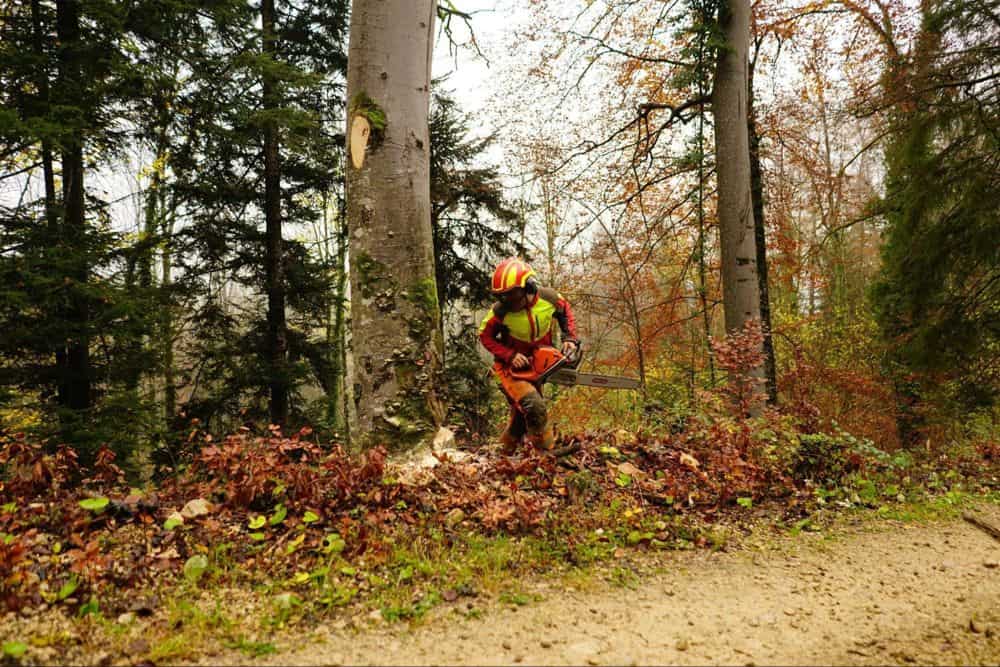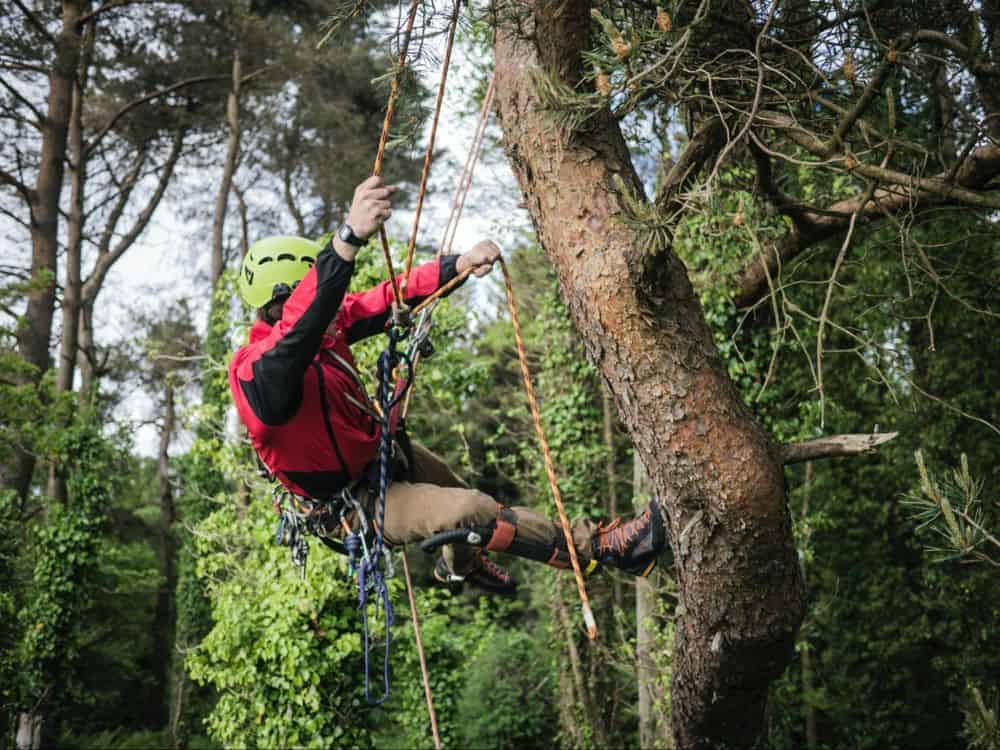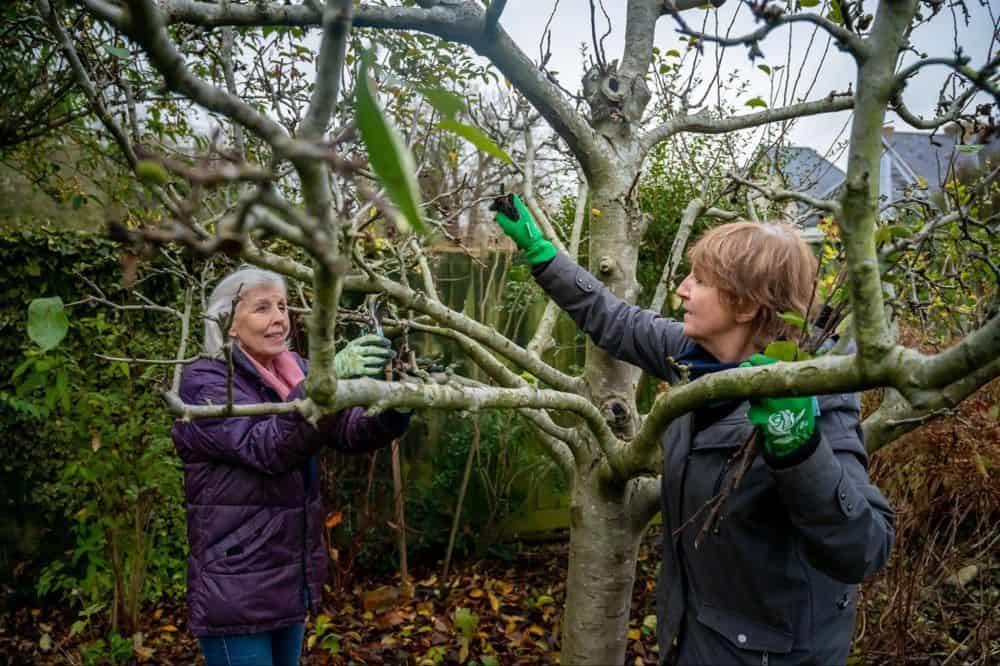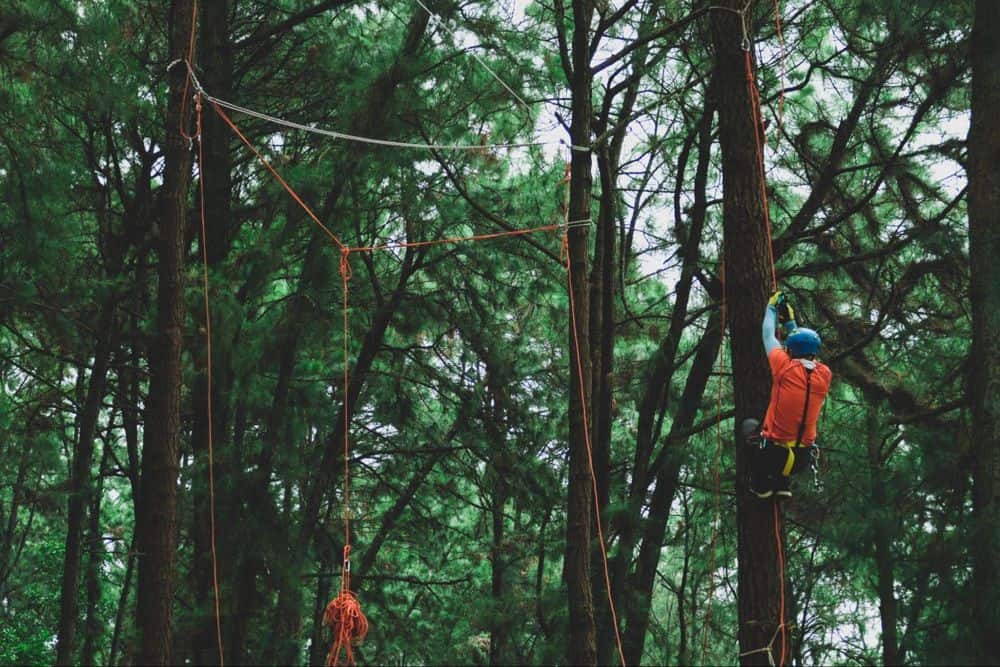In the world of arboriculture, the right tools are not a luxury but a necessity. Each tool serves a specific purpose, making tasks safer, easier, and more efficient. As an arborist, your toolkit should be well-equipped to handle any situation that comes your way. This article provides an in-depth look at ten essential tools every arborist should have in their arsenal. From chainsaws and boots to climbing gear and certification guides, we’ve got you covered. Let’s dive into the list and explore why each tool is crucial for your arborist journey.

1. Chainsaw
An arborist’s workhorse tool is undoubtedly the chainsaw. It’s indispensable for cutting down trees, trimming branches, and dealing with thick shrubs. Thus, having a reliable one is crucial.
When it comes to choosing the perfect chainsaw, a few key features must be considered:
- Power: The chainsaw must have enough power to handle your typical workload. This can be determined by the chainsaw’s engine size or battery voltage.
- Bar Length: The bar length should match the size of the trees you typically work with. Larger trees require longer bars.
- Weight: Remember, you might be using this tool for extended periods, so pick a chainsaw that is comfortable to hold and maneuver.
Speaking of recommended chainsaws, Husqvarna and Stihl offer excellent models that are widely used by arborists due to their power, reliability, and durability. For battery-powered alternatives, brands like Makita and DEWALT are worth considering.
2. Boots
The right pair of boots is not just about comfort and style for an arborist; it’s a matter of safety and productivity. A robust pair of boots can be the difference between a good day in the trees and an accident waiting to happen.
When choosing arborist boots, there are several key features to consider:
- Safety: Look for boots with steel or composite toe protection, puncture-resistant soles, and ankle support.
- Comfort: Arborists spend long hours on their feet. Opt for boots with cushioned insoles and good arch support.
- Durability: Tree work can be tough on footwear. Choose boots made from high-quality materials that can withstand the rigors of climbing and heavy-duty work.
Among the top-rated boots for arborists are the Haix Protector Ultra, renowned for their cut protection and stability, and the Arbpro EVO 2 boots, loved for their excellent grip and comfort. Both offer exceptional safety features tailored towards the unique needs of tree professionals. So remember, investing in the right footwear will not only protect your feet but also enhance your performance as an arborist.

3. Rope and Climbing Gear
When working at height, arborists depend heavily on their rope and climbing gear. These tools are not just a means to reach the high points in trees, but they also provide a safety lifeline for arborists.
There’s a diverse range of ropes available, each with unique properties and applications. Static ropes, for instance, are typically used for ascent and descent as they minimize stretch and movement. On the other hand, dynamic ropes are often employed in situations where shock absorption is required due to their elasticity.
Other key climbing equipment includes harnesses for body support, pulleys for efficient rope management, carabiners for secure attachments, and descenders which control the speed of descent.
When selecting climbing gear, safety should be your foremost concern. Look out for gear that meets industry standards and has been tested for strength and durability. Consider brands like Petzl, known for their robust climbing accessories, or Sterling Rope, which offers high-quality ropes designed specifically for arboriculture.
Efficiency is another critical factor to keep in mind. Gear that facilitates swift movement through trees can significantly enhance an arborist’s productivity. For example, ascenders from Camp USA or foot loops from Rock Exotica can make tree climbing quicker and less tiring.
In essence, investing in reliable rope and climbing gear is non-negotiable if you are to carry out your tasks safely and effectively as an arborist.
4. Helmet and Gloves
Arborists face inherent risks in their profession, making the use of protective gear like helmets and gloves a vital part of their toolkit. A good helmet protects the head from falling debris, while sturdy gloves provide grip and shield hands from cuts and abrasions.
When choosing a helmet, key features to consider include:
- Impact Protection: The helmet should meet industry standards for impact resistance.
- Comfort and Fit: The helmet should fit well without causing discomfort. Look for adjustable straps and padding.
- Ventilation: Helmets with ventilation holes can help keep you cool during strenuous work.
For gloves, important features to look out for are:
- Material: Leather or synthetic materials offer excellent durability and protection.
- Grip: Look for gloves with enhanced grip features to handle tools securely.
- Flexibility: Gloves should not restrict hand movements.
There are many highly-rated options available on the market. For helmets, the Petzl Vertex Vent Helmet provides outstanding comfort, adjustability, and protection. When it comes to gloves, the Youngstown Glove Company’s Leather Utility Plus gloves offer superior durability, grip, and dexterity.
Remember that your safety is paramount. Investing in quality protective gear is not just important—it’s essential in this line of work.

5. Loppers, Pruners, and Hand Saws
As an arborist, your hand tools form the backbone of your toolkit, with loppers, pruners, and hand saws taking the spotlight. These instruments are crucial for efficient pruning and branch-cutting tasks.
Let’s delve into the different types of these hand tools:
- Loppers: These come in two main varieties – Anvil and Bypass. Anvil loppers have one straight blade that cuts as it closes onto a flat edge or ‘anvil.’ On the other hand, bypass loppers work like scissors, with two blades passing by each other to make the cut.
- Pruners, also known as secateurs: Available in anvil, bypass, and ratchet style. The choice depends on the nature of the task at hand.
- Hand Saws: Folding saws and straight-blade pruning saws are commonly used types by arborists.
Remember, the better your tools, the smoother your work process will be. Therefore, investing in top-notch loppers, pruners, and hand saws is non-negotiable for every serious arborist.
6. Climbing Accessories
Beyond the basic climbing ropes and gear, arborists should also consider investing in supplemental climbing accessories. Among these, harnesses, karabiners, and lanyards stand out as essential for not only achieving optimal working conditions but also ensuring safety during tree work.
Harnesses are vital as they provide comfort and security while climbing. Look for models that offer easy adjustment features, ample padding, and multiple tool attachment points.
Karabiners connect various parts of the climbing system together. Opt for ones that have a high strength rating and are easy to operate, even with gloves on.
Lanyards help in positioning and maneuvering around the tree. A good lanyard should be adjustable and come with a sturdy locking mechanism.
Keep in mind that having the right accessories can significantly enhance your climbing experience, making your job smoother and safer.
7. Chipper and Stump Grinder
Arborists often deal with enormous amounts of tree debris, including branches and stumps. A chipper and a stump grinder are invaluable machines that make this task more manageable. Chippers reduce branches into woodchips suitable for mulching or composting, while stump grinders pulverize leftover tree stumps into sawdust.
When selecting a chipper or stump grinder, consider factors like power source (gas or electric), grinding capacity (diameter of the branch or stump it can handle), portability, and safety features. For instance, a chipper should have a feed hopper large enough to guide the branches into the chipping blades safely.
Popular models in the market include the Sun Joe CJ601E Electric Wood Chipper known for its efficiency and compact design, and the Powerking Stump Grinder, which stands out for its powerful motor and user-friendly operation. Each tool offers unique strengths; therefore, choose based on specific needs and preferences.

8. Rope Bag and Throw Line
As an arborist, you’ll understand the hassle of tangled ropes and the need for a practical storage solution. A rope bag is an essential item to keep your gear organized and ready for use. Not only does it ensure longevity and optimal performance of the ropes by protecting them from dirt, moisture, and abrasion, but it also enhances mobility on the job site.
Moving onto the throw line, this tool offers numerous benefits. Used in conjunction with a throw weight, it allows precise positioning of your climbing line or friction saver in the tree canopy. The throw line is typically lightweight and strong, ensuring easy launching over branches while minimizing the risk of entanglement.
Investing in quality rope bags and throw lines adds efficiency to your work routine and prolongs the lifespan of your equipment.

9. Arborist Certification Study Guide
Just as crucial as having the right tools is ensuring your knowledge and skills are up to par. Enter the arborist certification study guide. Designed to bolster comprehension and application of arborist principles, these guides are your ticket to acing certification exams.
Acquisition of an arborist certification study guide should be a priority. It serves as a roadmap, detailing essential topics and testable areas. Resources such as the “Certified Arborist Study Guide” by ISA or “Arborists’ Certification Study Guide Audio CDs” are highly regarded in the industry.
Remember, your approach to studying matters too. Practice makes perfect; take advantage of online quizzes and practice questions. Also, join study groups for collaborative learning and exam discussions. With the right resources and study techniques, certification success is within reach.
10. Additional Arborist Gear
Apart from the aforementioned tools, other essential arborist gear also plays a crucial role in ensuring safety and efficiency on the job.
Depending on specific tasks or situations, arborists might need additional equipment such as:
- Pole Saws: Extend your reach to trim higher branches without climbing.
- Wedges: Useful for controlling the direction of a tree’s fall when cutting it down.
- First Aid Kit: Accidents can happen, so it’s always wise to be prepared.
For instance, an arborist working near power lines would require insulated tools, whereas one working on diseased trees might need sterilized cutting tools to prevent disease spread.

In Conclusion
Remember, a well-equipped toolkit is not a luxury but a necessity for every professional arborist. It allows for safe, effective, and efficient work. Therefore, investing in high-quality arborist gear is an investment in your profession and safety.